In the world of e-commerce, a well-crafted product description can be the difference between a casual browser and a satisfied customer. The words you choose have the power to evoke emotions, highlight features, and ultimately persuade visitors to make a purchase. In this article, we’ll delve into the art of creating compelling product descriptions that entice customers to click that ‘Buy’ button.
- Know Your Audience
Before you put pen to paper (or fingers to keyboard), it’s crucial to understand your target audience. Research their preferences, pain points, and motivations. Tailor your product descriptions to resonate with their needs and desires.
- Focus on Benefits, Not Just Features
While it’s important to list the features of your product, remember that customers are ultimately looking for solutions to their problems. Explain how each feature translates into a benefit that enhances the customer’s life or addresses their pain points. For instance, if you’re selling a smartphone with a high-quality camera, emphasise how it captures stunning photos and helps preserve precious memories.
- Use Descriptive Language
Create vivid imagery with your words. Instead of simply saying “comfortable shoes,” describe them as “luxuriously cushioned shoes that cradle your feet in cloud-like softness.” Use adjectives that evoke sensory experiences and emotions, painting a picture of how the product will improve the customer’s life.
- Tell a Story
Humans are wired to connect with stories. Craft a narrative around your product to make it more relatable and memorable. Share the journey of how the product was developed, the problem it solves, or the inspiration behind its design. A story adds depth and personality to your description.
- Keep it Scannable
Online shoppers tend to skim through content. Make your product description easily scannable by using bullet points, subheadings, and short paragraphs. Highlight the most important information, such as key features, benefits, and unique selling points, so that it’s immediately visible to busy shoppers.
- Address Potential Concerns
Anticipate and address any doubts or concerns a customer might have. If you’re selling a skincare product, for example, acknowledge potential sensitivities and then emphasize that your product is dermatologist-tested and suitable for all skin types. This demonstrates transparency and builds trust.
- Inject a Touch of Personality
Your brand’s personality should shine through in your product descriptions. If your brand is playful and casual, let that come across in your writing. If it’s more professional and sophisticated, maintain that tone. Consistency in brand voice helps build recognition and trust.
- Use Social Proof
Incorporate customer reviews, testimonials, or ratings to showcase the positive experiences of previous buyers. Social proof adds credibility and reassures potential customers that they’re making a smart choice.
- Create a Sense of Urgency
Encourage customers to act by creating a sense of urgency. Limited-time offers, flash sales, or phrases like “while supplies last” can nudge hesitant buyers to make a quicker decision.
- Optimise for SEO
Lastly, optimise your product descriptions for search engines. Use relevant keywords that your target audience is likely to search for. Incorporate these keywords naturally into your description, but avoid overstuffing.
Crafting effective product descriptions is an art that requires a deep understanding of your product, your audience, and the psychology of persuasion. By focusing on benefits, using descriptive language, telling stories, and addressing concerns, you can create descriptions that not only inform but also inspire customers to take that final step and make a purchase.



